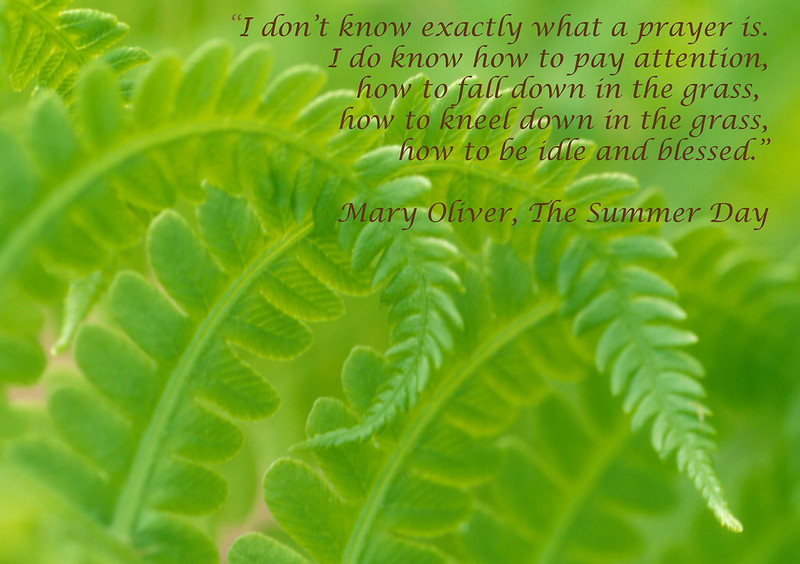
MARY OLIVER: Poetry and Peace
Another IPS (Inner Peace Symptom): an understanding that every form of Making is ultimately another way of practicing being human. [Humans make things. It’s how we connect with one another and with the World.]
I am pleased when I can wander through poet Mary Oliver’s words and borrow her eyes and her heart to see again the beauty and the mystery of Life-Its-Own-Self. The words remind me: I am not alone.
That one helps me get back to peace again amid the hurly-burly bustle and the noisy push-me, pull-you tumble fades away. AHHH….
My favorite Oliver quote does not come from a poem. It was part of a rare interview she gave with Rachel Martin on a 2012 National Public Radio’s “Weekend Edition Sunday.”
She said, “I said once, and I think this is true, the world did not have to be beautiful to work. But it is. What does that mean?”
That, I think, is a worthy big question. It’s certainly big enough to fuel a life-long work.

And then she wrote about it so the rest of us could see it too.
She also said, “One thing I do know is that poetry, to be understood, must be clear. It mustn’t be fancy. I have the feeling that a lot of poets writing now are… they sort of tap dance through it. I always feel that whatever isn’t necessary shouldn’t be in a poem.”
I do agree.
WOMAN OF A THOUSAND SONGS
Mary Oliver died at the beginning of 2019 at the age of 83. During her long and illustrious career that spanned over five decades, the prolific nature poet put together 26 collections of her verse, many of them best sellers.
There were also a number of prose books as well. She routinely put out a new book every couple of years, it seems.
She was that rare phenomenon: a poet whose work sold strongly.
Her prose books include two on the craft of poetry. A POETRY HANDBOOK and RULES FOR THE DANCE: A Handbook For Writing and Reading Metric Verse have been widely used in workshops and programs for beginning writers and wanna-be poetry appreciators.
A consummate artisan and word-lover, Oliver lays out the basics beautifully and well. She was a popular educator. She held the Catharine Osgood Foster Chair for Distinguished Teaching at Bennington College until 2001.
In 1984, she received a Pulitzer Prize for her fourth book, AMERICAN PRIMITIVE. In 1991 her HOUSE OF LIGHT won both the Christopher Award and the L.L. Winship/PEN New England Award and in 1992, her NEW AND SELECTED POEMS won a National Book Award. They were only a few of the many honors she received for her work.
Her work frequently appeared in many national magazines.
Oliver would probably have won the “People’s Choice” award (if they gave out that sort of thing in the poetry world). She was often dubbed “America’s best-beloved poet” despite some sour critic’s disparaging snark about her being “the poet laureate of the self-help biz and the human potential movement.”
A profoundly private person, Oliver rarely gave interviews, preferring to let her work speak for itself.
One of the best overviews of Oliver’s work and life can be found in the 2017 New Yorker magazine article by Ruth Franklin, “What Mary Oliver’s Critics Don’t Understand.” Click the button below if you’d like to read it.
As one who touched the hearts of many people with her unadorned, straightforward language and clear-eyed, humble observations of the natural world in all its glory as well as its impermanence and shadows and her joyous celebration of the Great Mystery that is Life-Its-Own-Self, Oliver was often quoted by clerics in their sermons, even though she admitted that she personally was not comfortable with religious institutions and dogma.
It didn’t matter. As a poet, Oliver was determined to make her life out of the simple but radical practice of paying close and deep attention to what was around her, and somehow, in doing so, she was reaching for the Divine.

Throngs turned out for her popular public readings as if she were some kind of reluctant bookish rock star or oracle. Many others read and spoke her work in public presentations.
In the following 2011 YouTube video, “What I Have Learned So Far” by Mary Oliver, the poem is spoken by students at Marquette University.
Inevitably, some of Oliver’s best lines were over-quoted, gracing coffee mugs, bumper stickers, assorted crafts and photography projects, and walls.


UMMM….POETRY SAVES LIVES?
Poetry therapy is a real thing. It has its own national (American) organization, The National Association for Poetry Therapy, which was incorporated in 1981. There is even an International Federation for Biblio/Poetry Therapy.
The American group provides credentials for poetry therapists, a sort of subculture among therapists (like the guys who use massage or hypnosis), who have successfully completed 440 hours of training and study. The international group has also developed a similar program of training and certification.
The idea that poetry can be used to help people who are suffering from inner turmoil apparently originated with New York psychiatrist Smiley Blanton. In his 1960 book THE HEALING POWER OF POETRY, he wrote:
“Suppose you are depressed and you read a poem about sadness. If your feelings overflow, if you find yourself crying, then your sadness is reduced. You realize that others have suffered, and the communion of feeling is helpful.. It is like being able to share your grief with someone else, someone who understands.”
The book, with its forward by Norman Vincent Peale, was reissued in 2012.
Poetry therapists use the power of verse that connects people heart-to-heart to help their clients explore and recognize their hurts and their brokenness in the hope that this will help them start to heal.
Some poems work; others not so much. Often the work of 19th century ecstatic, mystical, vision-walking poets – the “wisdom” poetry — serve this purpose better than other more modernistic offerings. Short poems work better than long ones. Clarity works better than obscure fancy-dancing.


The online service, founded by therapist Noah Rubinstein in 2007, is an information center for people looking for help and provides information about and access to a network of member mental health workers from over 25 countries.
A SPECIAL BOOKSTORE
One smile-inducing story is a new crowd-funded book store, The Poetry Pharmacy, that opened up in 2019 in a quiet small town, Bishops Castle, in rural Shropshire, on the borders of England and Wales.
(You can read Sheryl Grant’s story about the venture by clicking on the store name above.)
The store is the magical brainchild of writer Deborah Alma, self-dubbed the “Emergency Poet,” who spent years traveling round British festivals and literary events – tongue set firmly in cheek — in an old ambulance giving one-on-one “consultations,” listening to her patients’ tales of woe and “prescribing” a healing poem for them.
Alma called her service “the world’s first and only mobile poetic first aid service.”
I’m not sure whether the physical store is open during this time of the Covid-19 pandemic response madness, but it does sound delightful.
Who wouldn’t love a place where “poems are packed in jars and prescribed for heartbreak or stress, desire or mindfulness”? Alma’s consultations continue; tea and cookies and all sorts of wonderful books are served up in a charming Victorian-style setting.
I do know that you can access the store’s online offerings by clicking here:

Here’s a poem:
LOOKING FOR BELLS
A connoisseur of the absurdly profound once said,
“When a thing is true, you can let it alone.”
She’s right, you know,
‘Cause the thing sits itself down in your bones
And chimes out a clear pure note
That floats into the morning sky
When someone tells its story.
And you don’t even have to wonder
How or why such a thing might be, could be so.
Unless, of course, you are slow on the uptake like me
And you waste a lot of time wandering around
Listening to all the chiming
And looking for the bells.
By Netta Kanoho
Header photo credit:. “Dawn Blaze” by Angelo Juan Ramos via Flickr [CC BY 2.0]
Please note: If you would like to contribute a poem to this blog, please let me know by leaving a comment below. I’d be happy to hear from you.
I do ask three things of my guest poets:
- a poem of your own making that has great meaning and mana for you,
- the back-story for the poem — what inspired you or how you made it or whatever you want to tell about it, and
- an image that I can use as the featured photo in the header. (The last is optional. I do ask that the image you share is one you own — either an image of yourself or something that relates to the poem. If you choose not to send an image, then I’ll go find something that works.)
If you click on this thing –> “Guest Poet Portal” you can submit a poem right now.
Thanks for your visit. I’d appreciate it if you would drop a note or comment below and tell me your thoughts.
12 thoughts on “MARY OLIVER: Poetry and Peace”
Thank you for this article about Mary Oliver and her work. I had not heard of her before reading this article but I love seeing new reading material recommendations and I definitely love poetry.
I do agree fully that poetry as a form of therapy can be a very beneficial thing. I am interested in learning more about it so I will definitely look into the link you shared in the article.
Rachel, thank you for your visit and for sharing your thoughts. I do appreciate it.
Please do come again.
The very opening of the site is very beautiful. The thought of the inner peace symptom is really brilliant and beautiful. The images are really as if I am staring outside my window or they are right in front of me.
This is the kind of stuff I like to read or listen/meditate to when I’m outdoors or on the levee. This is a lovely page. Great Work!!
Meme, thanks for your visit and for sharing your thoughts. I do agree with you. The images — done by people who are willing to share their work (as long as they are credited for them) — are marvelous. It is why I chose them.
Please do come again.
Hmm, this has been an interesting read, but I do think that poems can be wonderfully valuable without having to be 100% clear. I do not need to spell out things exactly as I experience them or want them to be heard – I think that a lot of value comes in the interpretation, which is unique to each person.
One of my favorite things about art is that it is subjective and that the beauty and meaning is in the eye of the beholder.
Thanks for the visit and for sharing your thoughts. I do agree with you that what a member of an audience brings to any work of art can be extremely valuable. The whole thing about art is connection and communication and, very often, we resonate with bits of work that we don’t really understand fully but which tugs at our hearts and minds.
For healing, however, it’s often a help to have a straightforward bit to consider. If some work of art makes a very strong stance, you can learn a lot about yourself from your reaction to that stance, I think. Sometimes your own confusion eases as a result.
Both ways are most valuable.
Please do come again….
Thank you for the beautiful article on Mary Oliver and her poetry. I wasn’t familiar with her poetry before I read your article.
I love poetry about nature, and I didn’t realize that they used poetry to help people grieving and depressed. The thought that poetry can help someone who is grieving by reading a poem about grief amazes me. Also, the images are amazing.
Carol, thanks for your visit and for sharing your thoughts. I’m pleased you enjoyed the post.
Please do come again.
I like what Mary said that what isn’t necessary shouldn’t be in a poem. I also like that she is direct and not into fancy writing as she puts it. I think more writers should take note of these words of wisdom.
I also love the idea of the Poetry Pharmacy. Must be a wonderful place to visit and get a bottle of inspiration for yourself to suit the mood you are in.
Michel, I’m so glad you enjoyed the post.
Please do come again.
Your post celebrates the work and impact of poet Mary Oliver, and it also delves into the field of poetry therapy. It’s a thoughtful piece that highlights the power of poetry to touch the human soul, provide solace, and serve as a means of self-expression.
I personally love how it combines the appreciation of a renowned poet with insights into poetry’s therapeutic potential, making it a touching and informative read. It also invites readers to engage with poetic form and share their own work. Great job! 📚📖🖋
Thanks for your visit and for your kind words, Thomas. I do appreciate it.
Please do come again.